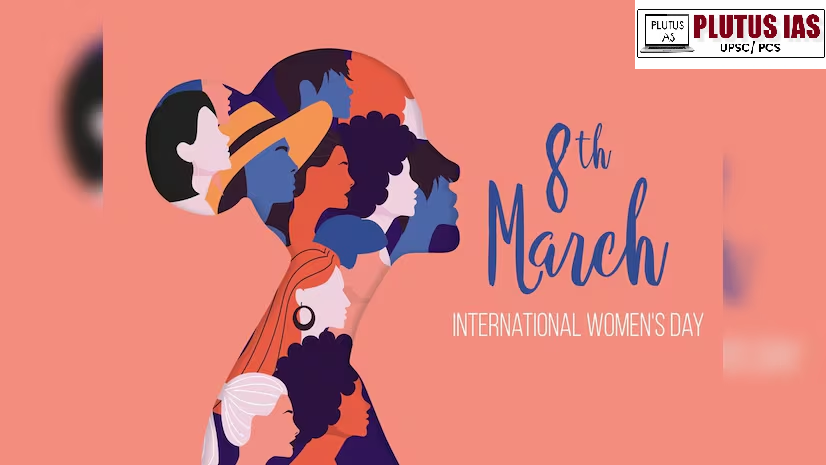08 Mar International Women’s Day
This article covers “Daily Current Affairs” and Topic details International Women’s Day
SYLLABUS MAPPING:
GS- 2- Social issue – International Women’s Day
FOR PRELIMS
What are the challenges faced by women entrepreneurs in India?
FOR MAINS
Why in the news?
International Women’s Day (IWD) is an annual global celebration that aims to educate society on the remarkable women’s rights movement while celebrating the cultural, political, and socio-economical achievements of women and girls. It is annually celebrated on March 8 every year, and in 2025, it will be falling on a Saturday. This day marks a call to action for accelerating gender parity and highlighting the ongoing efforts for continued advocacy and action worldwide.

Background of International Women’s Day
Vladimir Lenin declared March 8 as International Women’s Day in 1922 to honour the women’s role in 1917 Russian Revolution; it was subsequently celebrated on that date by the socialist movement and communist countries. The holiday became a mainstream global holiday following its promotion by the United Nations in 1977.
Origins & Key Milestones
1908: 15,000 women marched in New York for better rights.
1910: Clara Zetkin proposed IWD at a socialist conference.
1911: First IWD observed in Austria, Denmark, Germany, and Switzerland.
1913: March 8 became the official date.
1917: Russian women’s protests led to voting rights.
1975: UN officially recognized IWD.
Empowering Women in India
1. Government Schemes for Women Empowerment
Beti Bachao Beti Padhao (2015): Promotes the survival, protection, and education of girls.
Mahila Shakti Kendra (2017): Provides skill development and employment opportunities.
One Stop Centre Scheme (2015): Supports women facing violence with legal and medical aid.
Ujjwala Yojana (2016): Provides free LPG connections to women from poor households.
Sukanya Samriddhi Yojana (2015): Savings scheme for girls’ education and marriage.
Working Women Hostel Scheme: Ensures safe accommodation for working women.
Nari Shakti Puraskar: National award recognizing women achievers.
2. Legal Acts for Women’s Rights
The Dowry Prohibition Act (1961): Ban dowry in marriages.
The Protection of Women from Domestic Violence Act (2005): Protects against domestic abuse.
The Sexual Harassment of Women at Workplace Act (2013): Ensures a safe work environment.
The Maternity Benefit Act (1961, amended in 2017): Provides paid maternity leave.
The Hindu Succession Act (2005 Amendment): Grants equal property rights to daughters.
The Prohibition of Child Marriage Act (2006): Prevents early marriages.
3. Policies for Women’s Empowerment
National Policy for the Empowerment of Women (2001): Focuses on education, health, and economic empowerment.
Reservation for Women in Panchayati Raj (1993): 33% reservation in local governance.
Women Entrepreneurship Platform (WEP): Supports women-led startups.
Mission Shakti (2022): Merges various women’s welfare schemes for better implementation.
Issues hindering Women’s Empowerment in India
1. Cultural & Social Barriers: Patriarchal Mindset Restricts women’s choices and public participation.
2. Education Disparity: Rural girls face limited access to quality education, leading to lower literacy rates and fewer opportunities.
3. Economic Dependence: Restricted access to jobs, finance, and land ownership keeps women financially dependent on men.
4. Child Marriage: Early marriage deprives girls of education, increasing poverty and dependence.
5. Domestic Violence: Physical, emotional, and sexual abuse limits women’s ability to assert their rights.
6. Dowry System: Dowry demands lead to financial strain and violence, including bride burning.
7. Workplace Discrimination: Women face unequal pay, limited promotions, and sexual harassment at work.
8. Legal Awareness & Enforcement Issues: Laws exist but are poorly implemented, and women struggle to access justice.
9. Gender Bias in Healthcare: Poor access to reproductive and general healthcare affects women’s well-being.
10. Rural-Urban Divide: Rural women face greater challenges in education, healthcare, and employment than urban women.
Way forward
1. Strengthening Education & Awareness: Encourage STEM education for girls and integrate gender sensitization into school curricula.
2. Economic Inclusion: Promote women-led entrepreneurship and ensure equal pay for equal work.
3. Strict Law Implementation: Improve legal enforcement and create fast-track courts for gender-based crimes.
4. Social Change Campaigns: Run media campaigns to challenge patriarchal norms and promote gender equality.
5. Enhancing Political Representation: Advocate for women’s participation in governance beyond 33% reservation.
6. Better Healthcare Access: Increase affordable healthcare services, especially in rural areas, focusing on maternal health and family planning.
7. Technology & Digital Inclusion: Bridge the digital divide by ensuring women’s access to technology and financial literacy programs.
Conclusion
While significant progress has been made in women’s empowerment, challenges persist due to deep-rooted societal norms and economic disparities. A multi-sectoral approach involving the government, private sector, and civil society is crucial to achieving true gender equality. International Women’s Day serves as a powerful reminder to continue the fight for women’s rights and create a more inclusive and equitable society for future generations.
“Empowered women empower the nation!”
Download Plutus IAS Current Affairs (Eng) 8th March 2025
Prelims Questions:
Q. Consider the following statements:
1. The Beti Bachao Beti Padhao scheme aims to improve child sex ratio and promote girls’ education.
2. The Maternity Benefit Act, 2017, increased paid maternity leave to 26 weeks for all working women in India.
3. The Dowry Prohibition Act, 1961, makes the giving and receiving of dowry a punishable offence.
How many of the statements given above are correct?
A. Only one
B. Only two
C. All three
D. None
Answer: B
Mains Questions:




No Comments